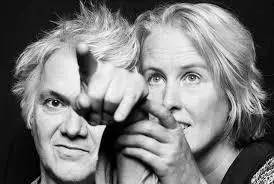Related Research Articles

Performance art is an artwork or art exhibition created through actions executed by the artist or other participants. It may be witnessed live or through documentation, spontaneously developed or written, and is traditionally presented to a public in a fine art context in an interdisciplinary mode. Also known as artistic action, it has been developed through the years as a genre of its own in which art is presented live. It had an important and fundamental role in 20th century avant-garde art.

Jodi, is a collective of two internet artists, Joan Heemskerk and Dirk Paesmans, created in 1994. They were some of the first artists to create Web art and later started to create software art and artistic computer game modification. Their most well-known art piece is their website wwwwwwwww.jodi.org, which is a landscape of intricate designs made in basic HTML. JODI is represented by Upstream Gallery, Amsterdam.
Martha Rosler is an American artist. She is a conceptual artist who works in photography and photo text, video, installation, sculpture, and performance, as well as writing about art and culture. Rosler's work is centered on everyday life and the public sphere, often with an eye to women's experience. Recurrent concerns are the media and war, as well as architecture and the built environment, from housing and homelessness to places of passage and systems of transport.
Cyberfeminism is a feminist approach which foregrounds the relationship between cyberspace, the Internet, and technology. It can be used to refer to a philosophy, methodology or community. The term was coined in the early 1990s to describe the work of feminists interested in theorizing, critiquing, exploring and re-making the Internet, cyberspace and new-media technologies in general. The foundational catalyst for the formation of cyberfeminist thought is attributed to Donna Haraway's "A Cyborg Manifesto", third wave feminism, post-structuralist feminism, riot grrrl culture and the feminist critique of the alleged erasure of women within discussions of technology.

Hannah Wilke was an American painter, sculptor, photographer, video artist and performance artist. Wilke's work is known for exploring issues of feminism, sexuality and femininity.
Faith Wilding is a Paraguayan American multidisciplinary artist - which includes but is not limited to: watercolor, performance art, writing, crocheting, knitting, weaving, and digital art. She is also an author, educator, and activist widely known for her contribution to the progressive development of feminist art. She also fights for ecofeminism, genetics, cyberfeminism, and reproductive rights. Wilding is Professor Emerita of performance art at the School of the Art Institute of Chicago.

Feminist art is a category of art associated with the late 1960s and 1970s feminist movement. Feminist art highlights the societal and political differences women experience in their lives. The hopeful gain from this form of art is to bring a positive and understanding change to the world, in hope to lead to equality or liberation. Media used range from traditional art forms such as painting to more unorthodox methods such as performance art, conceptual art, body art, craftivism, video, film, and fiber art. Feminist art has served as an innovative driving force towards expanding the definition of art through the incorporation of new media and a new perspective.
Audiovisual art is the exploration of kinetic abstract art and music or sound set in relation to each other. It includes visual music, abstract film, audiovisual performances and installations.
VNS Matrix was an artist collective founded in Adelaide, Australia, in 1991, by Josephine Starrs, Julianne Pierce, Francesca da Rimini and Virginia Barratt. Their work included installations, events, and posters distributed through the Internet, magazines, and billboards. Taking their point of departure in a sexualised and socially provocative relationship between women and technology the works subversively questioned discourses of domination and control in the expanding cyber space. They are credited as being amongst the first artists to use the term cyberfeminism to describe their practice.

Cornelia Sollfrank is a German digital artist, she was an early pioneer of Net Art and Cyberfeminism in the 1990s.

Dara Birnbaum is an American video and installation artist. Birnbaum entered the nascent field of video art in the mid-to-late 1970s challenging the gendered biases of the period and television’s ever-growing presence within the American household. Her oeuvre primarily addresses ideological and aesthetic features of mass media through the intersection of video art and television. She uses video to reconstruct television imagery using materials such as archetypal formats as quizzes, soap operas, and sports programmes. Her techniques involve the repetition of images and interruption of flow with text and music. She is also well known for forming part of the feminist art movement that emerged within video art in the mid-1970s. Birnbaum lives and works in New York.

Internet art is a form of new media art distributed via the Internet. This form of art circumvents the traditional dominance of the physical gallery and museum system. In many cases, the viewer is drawn into some kind of interaction with the work of art. Artists working in this manner are sometimes referred to as net artists.
subRosa is a cyberfeminist organization led by artists Faith Wilding and Hyla Willis.
Susanna Paasonen is a Finnish feminist scholar. She is a Professor of Media Studies at the University of Turku, and was a visiting scholar at MIT in 2016. She gained her PhD from the University of Turku in 2002; her dissertation was on gender and the popularization of the internet, which was later published through Peter Lang. After holding positions at the universities of Tampere, Jyväskylä and Helsinki, Paasonen was appointed Professor of Media Studies at the University of Turku on 1 August 2011, and publishes on internet research, media theory, sexuality, pornography and affect.
Nina Sobell is a contemporary sculptor, videographer, and performance artist. She began creating web-based artworks in the early 1990s.
Cheryl Donegan is an American conceptual artist. She is known for her video works, such as Head (1993) and Kiss My Royal Irish Ass (1992), which targeted the cliches of the female body in art and other issues of art politics.
Beverly Semmes is an American artist based in New York City who works in sculpture, textile, video, photography, performance, and large-scale installation.
Tina La Porta is a Miami-based digital artist who "focuses on issues surrounding identity in the virtual space". She was born in Chicago, Illinois in 1967. Her early work could be characterized as net:art or internet art. In 2001 she collaborated with Sharon Lehner on My Womb the Mosh Pit, an artistic representation of Peggy Phelan's Unmarked. La Porta is known for political and feminist art that explores gender, bodies and media such as the 2003 installation Total Screen which consists of enlarged Polaroid photographs of veiled men and women in TV news coverage after the events of 9/11. Later work explores mental illness and pharmaceuticals. In 2012 she presented Medicine Ball at the Robert Fontaine Gallery as part of the "Warhol is Over?" exhibition; this followed a 2011 presentation of All the Pills in My House, also at Fontaine's gallery. In 2015 she participated in the 40-person Annual Interest exhibition at the Young at Art Museum.
Radhika Gajjala is a communications and a cultural studies professor, who has been named a Fulbright scholar twice.

For the American jurist, see Nancy Paterson.
References
- ↑ Fuzzy Logic exhibit, MoMA PS1.
- 1 2 "Artist Statement". Prema Murthy. Retrieved 2023-12-19.
- ↑ "Bio". Prema Murthy. Retrieved 2020-03-14.
- ↑ REDDY, VANITA (2016-02-01). Fashioning Diaspora. Temple University Press. ISBN 978-1-4399-1156-3.
- ↑ Sollfrank, Cornelia (May–June 2015). "Revisiting CaberFeminism". Art Papers Magazine. 39 (3): 29–33.
- ↑ Dennis, Kelly (2009). "Gendered Ghosts in the Globalized Machine: Coco Fusco and Prema Murthy". pp. 79–86.
- ↑ Rachel Greene, Internet Art (World of Art) (Thames & Hudson, 2004), pp. 212-14; Kelly Dennis, "Gendered Ghosts in the Globalized Machine: Coco Fusco and Prema Murthy," Paradoxa: International Feminist Art Journal, Vol. 23 (2009): pp. 79-86.
- ↑ "Bindigirl - Interview with Prema Murthy," Rhizome.org (2 June 1999); González, Jennifer. "Morphologies: Race as a Digital Technology," in Re:Skin, ed. Mary Flanagan and Austin Booth (MIT Press, 2009), pp. 346-48; Andrea Grobler and Ingrid Stevens, "Pornography, Erotica, Cyberspace and the Work of Two Female Artists," South African Journal of Art History vol. 25 (2010): pp. 17-28.
- ↑ Josephine Bosma, "Interview: Prema Murthy," Old Boys Network Reading Room (January 2001); Christopher L. McGahan, "Re-Posing Porn and the Racialized Subject in Cyberculture: Prema Murthy's Bindigirl, Cyberfeminism, and the Culturalist Politics of Orientalized Pornography on the Internet," Racing Cyberculture: Minoritarian Art and Cultural Politics on the Internet (Routledge, 2013), pp. 123-161. See also Murthy's essay "Ito Ay Panaginip Sa Ibang Pangungusap" (This is a Dream Not of a Common Language) in Cyberfeminism: Next Protocols, edited by Claudia Reiche and Verena Kuni (Autonomedia, 2004).
- 1 2 Helena Reckitt, "From Bindi Girls to Space Invaders: Prema Murthy," ArtAsiaPacific, vol. 39 (2004): 34-35.
- ↑ Come As You Are: Art of the 1990s, Montclair Art Museum.
- ↑ "Swapna Vora on Prema Murthy". www.asianart.com. Retrieved 2023-12-20.
- ↑ Catherine Bernard, "Bodies and Digital Utopia," Art Journal 59.4 (2000): 26-31; Jay David Bolter and Diane Gromala, Windows and Mirrors: Interaction Design, Digital Art, and the Myth of Transparency (MIT Press, 2005), pp. 96ff.; Bosma, "Interview: Prema Murthy."
- ↑ Ars Electronica 1999; SIGGRAPH 2000; Whitney Biennial Art Port. See also "Now Anyone Can Be in the Whitney Biennial", The New York Times (23 March 2000).
- ↑ Saltworks Gallery.
- ↑ Grice, Helena; Parikh, Crystal (2015-08-20), "Feminisms and Queer Interventions into Asian America", The Cambridge Companion to Asian American Literature, Cambridge University Press, pp. 169–182, ISBN 978-1-316-15501-1 , retrieved 2023-12-20